Well, it was inevitable. Ever since I started playing what I call “Matrix chess” against the computer (i.e., games at a 40 moves/10 minutes time control with one timeout per game where I can take unlimited time), it was inevitable that a game would come along where I would want to take two timeouts. Sure enough, against Shredder yesterday I took a timeout on move 20, and then on move 46 we got to a position that was so fascinating that I could not bear the thought of playing some stupid move and then finding out after the game what I should have done. So I stopped the clock again.
I know, it’s a slippery, slippery slope. But these games are just for training, right? They’re not for realsies.
Anyway, take a look at the positions and see what you would have done. (By the way, I set Shredder at a strength of 2201 for this game.)
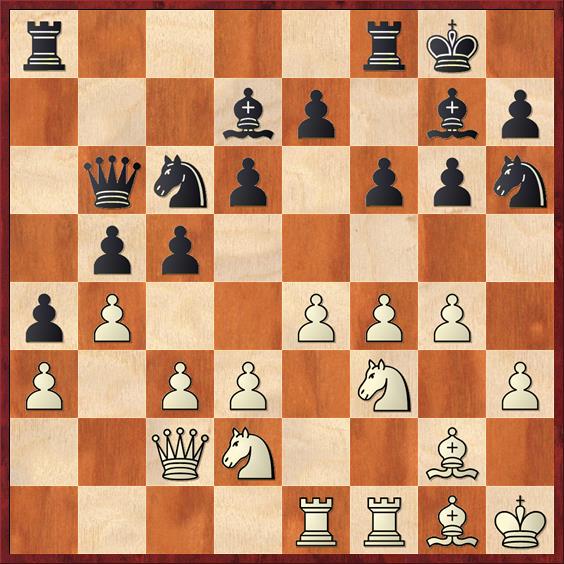 Position after 19. … f6. White to move.
Position after 19. … f6. White to move.
FEN: r4rk1/3bp1bp/1qnp1ppn/1pp5/pP2PPP1/P1PP1N1P/2QN2B1/4RRBK w – – 0 20
I was White here. This was a Grand Prix Sicilian that has gone incredibly well for White. The computer has wasted a lot of time with incomprehensible maneuvers like Ra8-b8-a8 and Bc8-e6-c8-d7, I think because it was a closed position and it was having trouble forming a plan. Meanwhile, I’ve gotten all my pieces developed to just about their optimum positions, and I also managed to close down Black’s queenside play.
In short, I felt that my preparations were complete, and it was time to start making some concrete threats. I took a timeout here to decide between the three pawn levers 20. e5, 20. f5, and 20. g5.
My very first instinct was to play 20. f5 because that is a common move in the Grand Prix Sicilian. However, as soon as I started looking at 20. e5! it became clear that it was a much better choice. The move 20. e5 liberates three of White’s minor pieces: it opens up the long diagonal for the light-square bishop, it opens up the square e4 for the knight, and it undermines Black’s queenside pawn chain and in that way makes the dark-square bishop more effective.
Very often a move like 20. e5 is a pawn sacrifice, but here I don’t even have to sac a pawn! If Black tries to win the pawn on e5, I will either get the pawn on c5 in return or else I will win the exchange on a8 — and either way, I have a very significant advantage.
Not only that, Black cannot play either of the “push past” moves, 20. … d5 or 20. … f5, because 20. … d5 loses the c-pawn and 20. … f5 loses the knight after 21. g5.
Finally, 20. e5 threatens to push the pawn on to e6. Although that makes the pawn structure more static, this kind of “bone-in-the-throat” pawn is often very effective at dis-coordinating the opponent’s position.
It’s very rare to find a move with so many pluses and not a single drawback. So I played 20. e5 and, no surprise, got a terrific position after 20. … fe 21. fe Kh8 22. e6 Bc8 23. bc dc 24. Ne4. Black either has to give up the c-pawn or the exchange, and he decided to sac the exchange with 24. … Bxe6 25. Nxc5 Bd5 26. Nd7 Qa5 27. Nxf8 Rxf8.
At this point Rybka shows White enjoying a huge advantage, like 2½ pawns. But something went wrong over the next few moves to make the position very competitive again. I’ll give them without annotation (almost), so that you can tell me everything I did wrong.
28. Ng5 Rd8 29. Bxd5 Rxd5 30. Ne4 Qc7 31. Be3 Ne5 32. Bf4 Qc8 33. d4? …
No matter what the computer may say, I think this is the beginning of my problems. I thought that I was giving more stability to my pawn formation, but really this move allows every Black piece to have a nice, active square. The knight on c4 is definitely worth more than three pawns, because the threat to capture on a3 immobilizes White’s most powerful piece, the queen. At some point, White will probably have to let that pawn go, but then Black will have really serious compensation for the exchange.
33. … Nc4 34. Qc1 Nf7 35. Ng5 Nxg5 36. Bxg5 e5 37. Bh6 Qc6 38. Kg1 Rd7 39. Bxg7+ Kxg7 40. Rf2 ed 41. cd Qd6 42. Kg2 …
The a-pawn is a goner, and White’s advantage is basically gone, too. But I have to wonder if Black’s next move might have been a little bit too hasty.
42. … Nxa3?! 43. Qc8! …
Activity, at last!
43. … Qd5+ 44. Kg1 …
The king’s wanderings between g1 and g2 are rather amusing in this game.
44. … Qd6
Evidently the computer would be satisfied with a draw. But I wasn’t.
45. Re8! …
Doubling on the seventh rank is a well-known attacking motif. Doubling on the eighth rank is less well known but often even more effective. Just as in real-life warfare, chess armies are usually not well prepared for an attack from the rear.
45. … Kh6!
This surprised me, but it’s really the only move. 45. … Qxd4? gets crushed by 46. Re7+! threatening Qf8 mate.
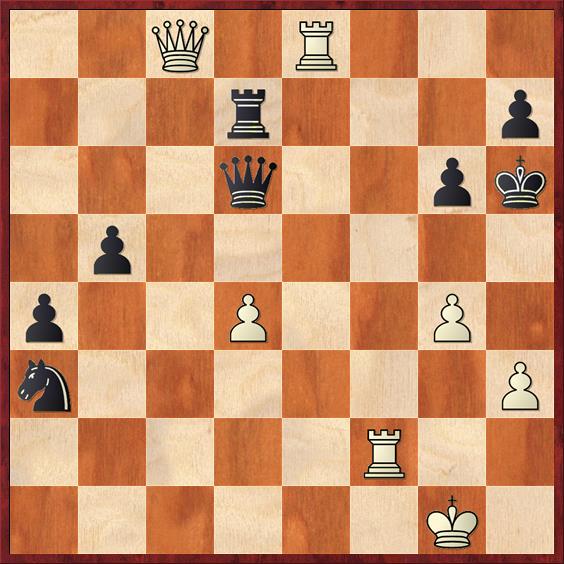 Position after 45. … Kh6. White to move.
Position after 45. … Kh6. White to move.
FEN: 2Q1R3/3r3p/3q2pk/1p6/p2P2P1/n6P/5R2/6K1 w – – 0 46
This was the position where I took my second, illegal timeout. I felt in my bones that I had to have something here, but I also felt sure that I would not be able to figure it out over the board in a limited-time situation, especially against a silicon adversary. I think I was right on both counts. The position is White to play and win. In a real game, I most likely would have played the first move, and I probably would have played the second move too, but it’s unlikely that I would have played the third move or the rest of the combination correctly.
In any case, this position is a wonderful analytic exercise, and if you have a half hour or an hour to think about it, I strongly recommend it. You should be able to work it out to a win or at least a very big advantage for White in all variations. There is more than one solution (Rybka chooses a different third move from the one I played).
(Space inserted in case you want to think about it.)
Step one: Lure the king farther forward.
46. g5+! …
I looked briefly at 46. h4, but I didn’t see any concrete mate threats. The h-pawn is not needed to support the g-pawn, and as we’ll see there are some very significant advantages to leaving it on h3.
Of course if Black takes he loses his queen for a rook: 46. … Kxg5? 47. Qc1+ Kh5 48. Re5+. So his move is forced.
46. … Kh5 47. Qc3 …
Step two: Bring the queen back into action. Her job on the back rank is done. She does several useful things here: prevent queen invasions on g3, threaten check on f3, and threaten the knight on a3.
47. … Nc4
This was the move I expected, but I also had to think very seriously about 47. … Qxd4, sacrificing the knight. There are lots of variations, but the key one, in my opinion, is 48. Qxa3 Qd1+ 49. Kh2 Qd6+ 50. Qxd6 Rxd6 51. Re5!
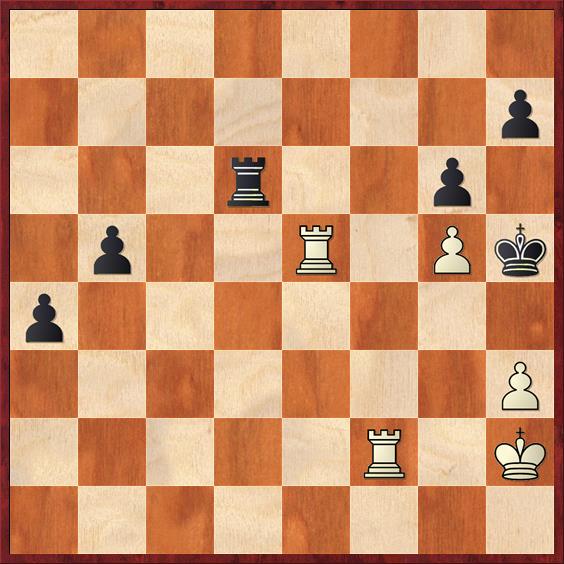 Position after 51. Re5. Black to move.
Position after 51. Re5. Black to move.
FEN: 8/7p/3r2p1/1p2R1Pk/p7/7P/5R1K/8 b – – 0 51
This is a move that I would almost certainly overlook in a blitz game, and might overlook in a tournament game, too. White makes no attempt to stop Black’s pawns — instead, he plays for checkmate! It’s easy to see that after either 51. … b4 or 51. … Rb6, 52. Rf7 sets up a mating net.
When you get to an endgame, it’s very easy to switch off the part of your brain that looks for checkmate possibilities. But in multi-piece endgames, checkmate can be an important weapon. But it’s different from the middlegame. In the middlegame you attack with the full intention of checkmating your opponent. In the endgame, checkmate threats are more of a diversion that allows you to achieve other goals. Here, because Black is forced to deal with the mate threat, he has to give up the b-pawn, and then of course the ending is a dead-easy win for White.
Now let’s go back to the game. Here’s the position in case you want to look for White’s next move.
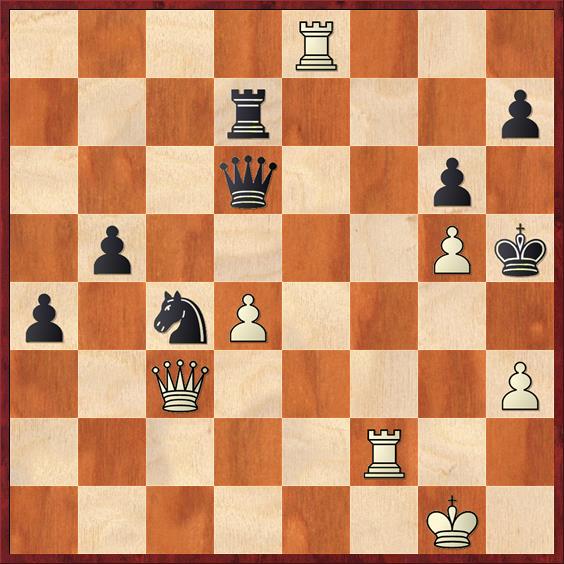 Position after 47. … Nc4. White to move.
Position after 47. … Nc4. White to move.
FEN: 4R3/3r3p/3q2p1/1p4Pk/p1nP4/2Q4P/5R2/6K1 w – – 0 48
Again, it’s White to play and win. There are two possibilities, one found by me and the other found by Rybka.
Ready? First Rybka’s variation: 48. Rg2!
Were you paying attention during the lesson about checkmate in the endgame? If so, then this is probably the move that you should play. I barely even gave this move a second thought, because I said “Oh, Black trades queens and probably has a winning endgame.” Wrong! After 48. … Qxd4+? 49. Qxd4 Rxd4 50. Re7, Black cannot escape the mating net!
Black has better moves than 48. … Qxd4, but still the prognosis for him is exceedingly gram after, say, 48. … Rf7 49. Re4.
However, I was oblivious to the whole queen-trade-and-checkmate idea, and in diagram four I played 48. Re4!, which I think also deserves an exclam.
Of course, this move suggested itself to me first as a way to defend the d-pawn, but there is much more to it than that. The first beautiful point is what happens if Black takes the g-pawn: 48. … Kxg5 49. Qc1+ Kh5 (diagram)
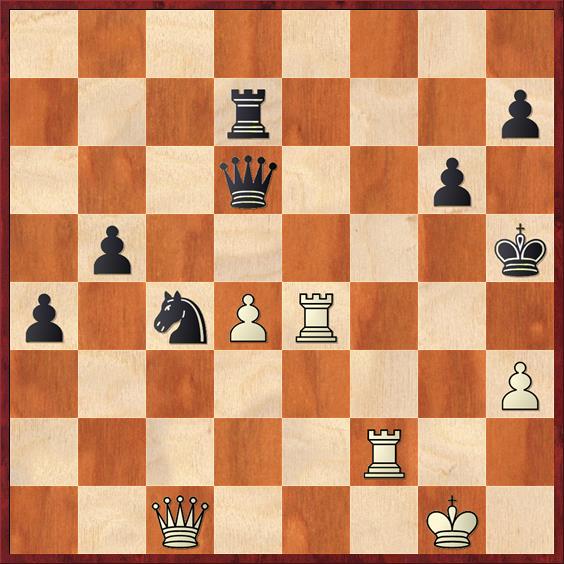 Position after 49. … Kh5 (analysis). White to move.
Position after 49. … Kh5 (analysis). White to move.
FEN: 8/3r3p/3q2p1/1p5k/p1nPR3/7P/5R2/2Q3K1 w – – 0 50
And White wins with 50. Rh4+!! Kxh4 51. Qh6+ Kg3 52. Qg5+ Kxh3 53. Rf3+.
When I saw this beautiful finish, I could not contain my excitement. Remember, I’m still on move 46, taking my time-out. This was the variation that really sold me on the fact that I had to play 46. g5+, not 46. h4, so that the h4 square would still be available for my rook. It also sold me on the move 48. Re4, and perhaps kept me from taking the alternative 48. Rg2 more seriously.
However, Black of course does not have to walk into the mating net, and he has another very good move. After 48. Re4! the computer played 48. … Qa3!
This very nearly wrecks White’s schemes, and it’s the sort of move that would probably make me panic and lose if I faced it in an over-the-board game. But the time-out gave me a chance to prepare my response. White has basically only one move to avoid the trade of queens and keep the attack going, so I played 49. Qe1!
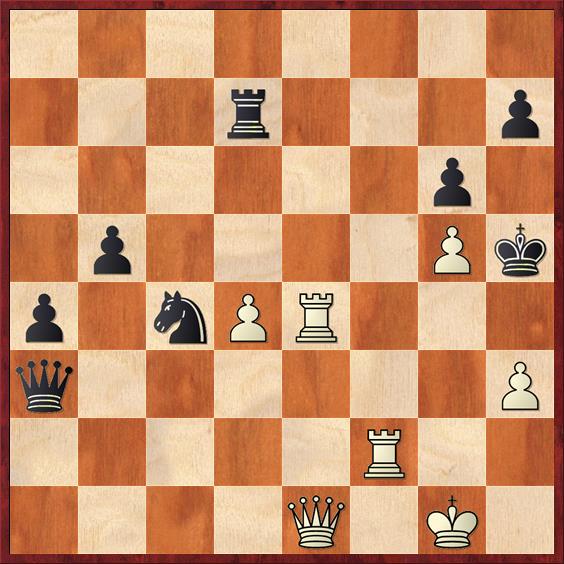 Position after 49. Qe1. Black to move.
Position after 49. Qe1. Black to move.
FEN: 8/3r3p/6p1/1p4Pk/p1nPR3/q6P/5R2/4Q1K1 b – – 0 49
Now remember, I’m still just playing through my analysis during the timeout! One important thing I had to figure out here is what to do if Black plays 49. … Kxg5. Do you see how White wins?
Answer: If 49. … Kxg5 I play 50. Ra2!! Once again, a spectacular rook sacrifice. If Black takes, then 50. … Qxa2 51. Qh4+ Kf5 52. Qf4 is a sudden checkmate. If 50. … Qxh3 51. Rh2! mate is coming soon.
Instead, the computer played the more prosaic 49. … Qg3+ 50. Kh1 Qxg5. All still foreseen during my timeout analysis. I continued 51. Rff4!, once again threatening mate on h4. Black played 51. … Kh6, which was forced. And now my queen ended her improbable journey with 52. Qc1!
The threat is 52. … Rh4+, separating the king from the queen, and it cannot be stopped. If 52. … Kh5 I play 53. Rh4+! anyway, and after 53. … Qxh4 54. Qd1+! I win the queen and should win the endgame.
Instead Shredder played 52. … Kg7, finally getting its king to safety but losing the queen after 53. Rf7+ Rxf7 54. Qxg5. At this point we finally left my timeout analysis! After a few more adventures, which were fortunately rather mild compared to the previous ones, I managed to win the game.
What a battle! In a tournament game, I doubt very much that I would have been able to solve the difficulties over the board. When you’re trying to attack, it’s psychologically hard to see “retreating” moves like 47. Qc3, 48. Re4, 49. Qe1 and 52. Qc1. And even if I saw them in a tournament game, I would be less confident in them.
So is it a waste of time to play a game in such manifestly un-tournament-like conditions? Well, I don’t want to make a habit of taking two time-outs a game, which will lead to three, and then four… But I do think that an exercise like this can improve the precision of your analysis and give you a target to strive for when you’re in a real tournament game.



{ 1 comment… read it below or add one }
I see no reason you should berate yourself for using your fascinating “timeout” method.
You’re clearly finding value in this approach.
More selfishly (from my point of view), we READERS love to read and follow-along with your play, and your analysis.